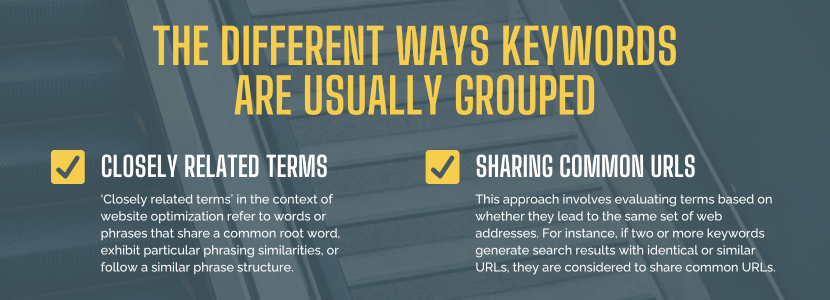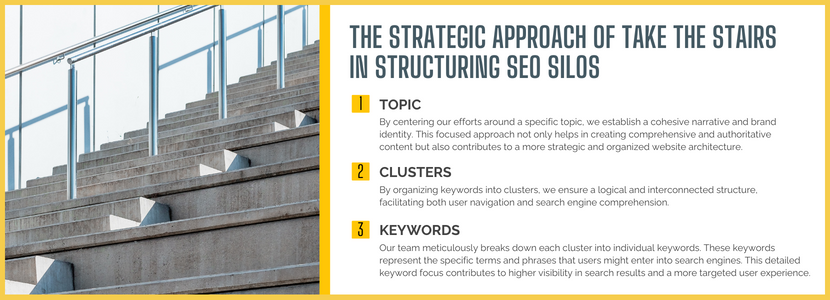Welcome to our comprehensive guide on SEO silos, an essential strategy for optimizing your website’s search engine performance. In the ever-evolving landscape of online content, mastering SEO (Search Engine Optimization) is crucial for enhancing visibility and attracting organic traffic. One powerful technique gaining prominence is SEO siloing, a strategic approach that involves structuring your website’s content around specific themes or topics.
In this guide, we will delve into the intricacies of SEO silos, exploring the importance of keyword organization, the fundamentals of SEO silo structure, and the impact it can have on your website’s overall search engine rankings. Additionally, we’ll address the question, “What is a keyword silo?” – an integral concept in understanding how to effectively implement this powerful SEO strategy.
Key takeaways
- Understand the fundamentals of SEO siloing, a strategic approach to organizing website content around specific themes or topics.
- Grasp the impact of SEO silo structure on overall search engine rankings and the importance of creating a clear hierarchy within your content.
- Understand the significance of keyword organization within SEO silos for creating a cohesive and optimized digital presence.
- Learn how internal linking within SEO silos strengthens topical connections, aids search engines in understanding content relationships and enhances the overall user experience.
- Explore how keyword silos contribute to building topical authority by demonstrating expertise and relevance within specific themes.
- Discover how keyword silos help improve your content strategy by uncovering new content opportunities, establishing topical authority, and identifying content gaps.
- Recognize the common challenges in implementing keyword silos, including meticulous keyword grouping, maintaining consistency, and balancing specificity and breadth.
- Familiarize yourself with various SEO tools such as SEMrush, Ahrefs, Google Analytics, and more, that can aid in the creation and optimization of keyword silos.
What exactly is an SEO silo?

An SEO silo is a strategic site structure that focuses on organizing content to enhance its relevance to specific themes, making it more favorable to search engines.
This silo structure involves dividing the website into distinct content silos or categories, each dedicated to a particular topic. These content silos are organized in a pyramid structure, with broader themes at the top and more specific subtopics underneath.
Within each silo, individual pages or subcategories are created to delve deeper into specific aspects of the theme. This hierarchical arrangement facilitates a logical flow of information, aiding both users and search engines in understanding the site’s topical expertise.
The goal is to signal to search engines that the website is an authoritative source in particular subject areas. The effectiveness of an SEO silo is not only in the content organization but also in the strategic use of internal links.
Internal linking within the silos helps to strengthen the topical relevance of the content. This careful interlinking is vital for the efficient flow of link juice – the value or authority passed between pages through links.
By optimizing the site structure and internal linking, a website can enhance its visibility on search engines, making it more likely to rank higher in search results for relevant queries. In summary, adopting an SEO silo strategy involves creating a well-organized site structure, implementing content silos, and optimizing internal linking to maximize the impact on search engine rankings.
This approach sends clear signals to search engines about the depth and specificity of the website’s expertise, contributing to improved visibility and authority within particular subject areas.
The concept of grouping related keywords and keyword synonyms
Keyword siloing involves organizing and categorizing related keywords based on thematic relevance. This strategic practice optimizes site structure and internal linking, forming the foundation for SEO silos or thematic content clusters.
By implementing a pyramid structure within these silos, businesses can signal to search engines their authority within specific subject areas.
The concept of a keyword silo is integral to SEO siloing, emphasizing the importance of keyword organization in creating a cohesive and optimized digital presence. This approach enhances internal linking and preserves link juice, ultimately improving a website’s visibility and authority on search engines.
How a keyword silo helps search engines understand content
A keyword silo is instrumental in optimizing search engines’ understanding of content. By categorizing related keywords into thematic groups within a structured SEO silo, clarity and context are provided to search engine algorithms. This approach facilitates the recognition of relevance and topical focus, establishing a clear hierarchy within the keyword silo.
Using internal links within the silo strengthens topical connections between pages, enhancing the overall keyword organization. This organized presentation aids search engines in accurately interpreting content, improving understanding of the website’s subject matter.
The keyword silo’s role as a structural guide contributes to effective content comprehension and indexing, ultimately boosting visibility and search engine performance for an SEO silo keyword.
How keyword silos create topical authority
A Keyword silo, an integral part of SEO siloing and structured site organization, contributes significantly to the establishment of topical authority. By grouping related keywords within specific silos, this SEO silo structure sends clear signals to search engines about the concentrated thematic focus of the content.
The use of internal links within the silo, forming a network in the pyramid structure, enhances the topical relevance and aids search engines in understanding content relationships.
A keyword silo, defined by its clear hierarchy in the site structure, establishes a strong organizational framework. This structure guides search engines in comprehending the depth and breadth of content within each silo, reinforcing the relevance of the site’s expertise.
The organization of content within keyword silos serves as powerful relevance signals to search engines. It signifies the website’s commitment to providing comprehensive and pertinent information on specific topics, thereby enhancing perceived authority in those areas and preserving valuable link juice.
Beyond benefiting search engines, keyword silos contribute to an improved user experience by presenting information in a logical and organized manner. Visitors can easily navigate through content related to their interests within these content silos, ultimately increasing user engagement and time spent on the site.
In summary, the strategic implementation of an SEO silo keyword, SEO silo structure, and keyword silos enhance topical authority by demonstrating expertise and relevance within specific themes.
This organizational approach, complemented by internal linking and a well-defined hierarchy, positions websites for higher rankings and increased visibility in search results for relevant queries.
What are the different ways keywords are usually grouped?
Keywords are typically grouped in various ways to optimize website content and enhance search engine optimization (SEO). One common method involves organizing keywords based on semantic themes, ensuring comprehensive coverage of related terms and concepts within the site architecture.
Additionally, keywords can be grouped according to product or service categories, aligning with the diverse offerings of businesses, and based on user intent to create targeted and relevant content for landing pages.
Geographic location is another significant grouping criterion for local businesses, allowing them to tailor their content to specific regions and optimize URL structure. Further strategies include categorization by buying funnel stages, distinguishing between long-tail and short-tail keywords through keyword research, and organizing keywords around seasonal themes for timely relevance in blog posts.
Brands often differentiate between brand and non-brand keywords, while competitor analysis can inform keyword grouping for strategic advantage and link structure. Content types, problem-solving approaches, and even alphabetical or numerical order are additional methods employed based on specific website content goals and internal linking structures.
The choice of grouping strategy depends on the nature of the website’s architecture, its objectives, and the preferences of the target audience.

Closely related terms
‘Closely related terms’ in the context of website optimization refer to words or phrases that share a common root word, exhibit particular phrasing similarities, or follow a similar phrase structure.
The closeness of their relationship is often evident in their linguistic elements, which may include shared prefixes, suffixes, or a common word stem.
For instance, in the context of keyword research or content optimization, closely related terms might involve variations of a core word, such as “run,” “runner,” and “running,” all sharing the root word “run.”
Additionally, terms with specific phrasing similarities, like “best running shoes” and “top-rated sneakers,” can be considered closely related due to their shared context and intent.
Recognizing and incorporating closely related terms is crucial in content creation, SEO, and semantic search, as it helps ensure that the content addresses a range of relevant queries and provides a comprehensive understanding of a given topic.
Sharing common URLs
If you’re grappling with where to begin in your SEO strategy, considering the ‘sharing common URLs’ method might be a suitable starting point. This approach involves evaluating terms based on whether they lead to the same set of web addresses.
For instance, if two or more keywords generate search results with identical or similar URLs, they are considered to share common URLs. While not a top-recommended strategy, it can be beneficial for tasks like content optimization, keyword clustering, and planning website architecture.
Identifying terms with common URLs indicates a likely relationship between associated content or web pages in terms of topic or intent. However, it’s essential to note that starting with comprehensive keyword research is generally recommended, as it allows you to cover a broader range of terms beyond those your website currently ranks for.
This approach helps streamline efforts in managing and optimizing content within the same cluster, contributing to a more cohesive and organized web presentation. Keep in mind that this strategy is only a starting point. You will want to do even more comprehensive research (using a keyword research tool) to find even more keywords your pages aren’t yet ranking for.
Why do SEOs use keyword silos?
SEO professionals employ SEO siloing as a strategic framework to optimize their efforts. The primary goals of implementing SEO siloing include enhancing content relevance, improving the user experience, and establishing a clear site architecture.
By organizing related keywords into specific thematic groups known as an SEO silo structure, practitioners create a logical and organized structure that benefits users and search engine crawlers alike.
This approach not only facilitates targeted content creation for comprehensive coverage of diverse user queries but also supports internal linking within each SEO silo. The internal linking reinforces the topical relevance of content and strategically distributes link authority throughout the site, aligning with the principles of keyword organization within a SEO silo.
SEO silos also play a pivotal role in sending strong signals to search engines about the website’s topical expertise, positively impacting search engine rankings. Furthermore, the structured approach of SEO silos enables SEOs to optimize for long-tail keywords and niche topics within specific themes, capturing highly targeted search traffic.
In essence, the implementation of SEO silos, guided by principles like SEO silo keyword and keyword organization, is a holistic strategy that enhances content organization, user engagement, and overall SEO performance.
Improved website structure
Keyword silos serve as a fundamental tool for organizing website content. By grouping related keywords into specific themes or topics, SEOs create a structured and hierarchical site architecture. This, in turn, enhances the overall user experience, making it easier for visitors to navigate and find relevant information.
Enhanced SEO and rankings
The implementation of keyword silos aligns with SEO best practices. By organizing content thematically, search engines can better understand the context and relevance of the information on the website. This contributes to improved search engine rankings, as algorithms interpret the structured content as more authoritative and valuable.
Targeted content for specific audiences
Keyword silos empower SEOs to tailor content to specific audience segments. Each silo can be crafted to address the unique needs and interests of a particular group, leading to more engaging and relevant content. This targeted approach not only satisfies user intent but also fosters increased user engagement.
The potential for increased organic traffic
The strategic use of keyword silos has the potential to drive increased organic traffic to a website. When content is optimized within these silos, the site becomes more visible for relevant search queries. This visibility, coupled with the improved website structure, attracts users actively seeking information related to the site’s themes, resulting in higher organic traffic.
How does Take the Stairs structure their SEO silos?

Take the Stairs employs a strategic approach to SEO silos, focusing on a central theme or ‘Topic’, such as digital marketing. Within this theme, we create ‘Clusters’ — groups of related keywords exploring specific subtopics like social media marketing or SEO strategies. Each cluster is populated with individual ‘Keywords’, representing the fine details of the content. This structured approach enhances visibility for diverse queries and ensures a coherent user experience.
Topic
The chosen topic, in this case, “digital marketing,” acts as the foundational pillar of Take the Stairs’ SEO silos. This overarching theme provides a clear and central focus for our content strategy. By centering our efforts around a specific topic, we establish a cohesive narrative and brand identity.
This focused approach not only helps in creating comprehensive and authoritative content but also contributes to a more strategic and organized website architecture.
Clusters
Within the broader topic of ‘digital marketing’, we strategically identify clusters of related keywords. These clusters serve as thematic groupings that align with various aspects of digital marketing.
For instance, the ‘social media marketing’ cluster may encompass keywords like ‘social media strategy’, ‘engagement tactics’, and ‘platform optimization’. Similarly, the ‘SEO’ cluster could include keywords such as ‘on-page optimization’, ‘backlink building strategies’, and ‘keyword research tools’.
By organizing keywords into clusters, we ensure a logical and interconnected structure, facilitating both user navigation and search engine comprehension.
Keywords
At a more granular level, our SEO team meticulously breaks down each cluster into individual keywords. These keywords represent the specific terms and phrases that users might enter into search engines.
For example, within the ‘keyword research’ cluster, individual keywords could include ‘long-tail keywords,’ ‘competitive analysis,’ and ‘search volume trends.’ By addressing specific keywords, we cater to diverse user intents and queries, ensuring a nuanced and comprehensive approach to content creation.
This detailed keyword focus contributes to higher visibility in search results and a more targeted user experience.
Our process for developing keyword silos
Our approach to developing keyword silos follows a systematic process aimed at creating targeted and effective content. Here’s a breakdown of our method:
Every keyword research project starts the same, by determining the topic
Every keyword research project begins with the identification of a central topic. This could range from a specific service area and unique business offerings to a distinctive value proposition or a new market entry. Defining this topic serves as the foundation for subsequent keyword research and content development.
Next, you’ll want to research and collect all of the relevant keywords you can
The next step involves thorough research to compile a comprehensive list of relevant keywords associated with the chosen topic. This process entails utilizing various keyword research tools, exploring industry trends, and considering user intent to ensure a diverse and exhaustive collection of keywords.
Group your keyword list into clusters
Once the keyword list is compiled, the next task is to group these terms into clusters based on their thematic relevance. Clusters typically revolve around subtopics or related concepts within the broader chosen theme.
This grouping not only organizes the keywords logically but also sets the stage for creating content that addresses specific aspects of the chosen topic comprehensively.
The extra step that only Take the Stairs takes
Our approach includes an additional step – tiering each individual term. This involves assigning a tier or level to each keyword based on its perceived value.
By categorizing keywords in this manner, we prioritize the most valuable terms, allowing for a more focused content creation strategy that emphasizes the terms with the greatest potential impact on our goals.
How do keyword silos help improve your content strategy

Keyword silos serve as a foundational element in optimizing and refining your content strategy, providing a structured framework that goes beyond mere organization. Here’s a detailed exploration of how keyword silos contribute to improving your content strategy:
Discover new content opportunities
Keyword silos encourage a comprehensive exploration of related keywords within a central theme. This process unveils new content opportunities by identifying specific subtopics, variations, and long-tail keywords associated with the primary theme.
The organized structure facilitates a systematic examination of potential content gaps and areas where users may be seeking additional information. By leveraging keyword silos, you can continually discover and address emerging trends, user queries, and industry developments, ensuring that your content remains fresh, relevant, and aligned with current interests.
Helps with topical authority
Building topical authority is a strategic benefit of employing keyword silos. By grouping related keywords into thematic clusters, you establish a comprehensive coverage of specific subjects, showcasing your expertise in those areas.
Search engines recognize this depth of content as a signal of authority and relevance. Over time, as you consistently develop and optimize content within these silos, you strengthen your position as a go-to resource within your industry or niche.
This contributes to improved search engine rankings, increased visibility, and enhanced credibility among your target audience.
Identifies content gaps
The process of creating keyword silos facilitates a thorough analysis of your existing content strategy. By examining clusters of related keywords, you can identify potential content gaps where your coverage may be insufficient.
This insight allows you to strategically address these gaps by creating targeted content that fills in missing information, answers specific user queries, or explores overlooked subtopics. Addressing content gaps not only enhances the overall depth and completeness of your content but also ensures that you are consistently meeting the diverse needs and expectations of your audience.
In essence, keyword silos serve as a dynamic and proactive tool within your content strategy. They empower you to continuously discover new content opportunities, establish topical authority, and strategically address any content gaps that may exist.
This structured approach not only benefits user experience but also aligns with search engine algorithms, contributing to improved visibility and performance in search results.
Frequently Asked SEO Silo Keyword Questions
Navigating the complexities of SEO silo keywords is a common challenge for businesses and digital marketers aiming to optimize their online presence. Understanding the intricacies of structuring content, identifying relevant keywords, and leveraging silo strategies is crucial for effective search engine optimization.
In this FAQ section, we address key questions surrounding SEO silo keywords to provide clarity on their significance, implementation, and their impact on overall SEO performance.
Can I implement keyword silos on an existing website?
Certainly, implementing SEO siloing on an existing website is a viable strategy to enhance SEO performance. It involves restructuring content by categorizing existing pages or creating new ones to fit within specific silos. This process aligns with SEO silo structure and keyword organization principles.
Start by conducting a comprehensive keyword analysis to identify relevant terms and themes, grouping them into thematic clusters. This forms the basis for your keyword silos. Establish internal links between related pages to create a logical hierarchy, aiding search engines in understanding the topical relevance of your content.
Monitoring changes using analytics tools, tracking keyword rankings, and assessing user engagement are crucial steps. This continual refinement ensures optimized keyword silos, positively impacting search engine visibility and user satisfaction. With careful planning and execution, integrating keyword silos into an existing website can yield significant benefits.
How many keywords should be in a cluster?

Ideally, a cluster should contain between 3 to 12 keywords. This range ensures a focused and manageable thematic grouping that is specific enough to signal topical relevance to search engines while also providing sufficient flexibility to cover related subtopics comprehensively.
Keeping the number of keywords within this range helps maintain the clarity and effectiveness of the SEO silo structure in supporting SEO efforts.
What is keyword cannibalization, and how can I avoid it?
Keyword cannibalization occurs when multiple pages on a website compete for the same target keywords, causing confusion for search engines and potentially diluting the effectiveness of your SEO efforts. Implementing an SEO silo keyword and a robust keyword organization strategy is crucial to avoid this issue.
A keyword silo is a method of grouping related keywords into thematic clusters or categories. This structured approach helps prevent keyword cannibalization by assigning specific themes or topics to each silo.
Within each silo, keywords are strategically organized, ensuring that individual pages target distinct, relevant terms. This not only improves the clarity of your content but also helps search engines understand the unique focus of each page.
What are some common challenges in implementing keyword silos?
Implementing keyword silos, a cornerstone of SEO siloing, offers significant benefits but comes with its set of challenges. The process involves restructuring content to align with specific themes or topics, creating a logical hierarchy, and optimizing internal linking.
While this approach enhances SEO performance through improved content organization and topical relevance, challenges arise in various areas.
One significant challenge is the meticulous task of identifying and grouping relevant keywords into cohesive silos. This requires in-depth keyword research to ensure each silo addresses distinct user intents while remaining comprehensive.
Maintaining consistency across silos poses another hurdle: the necessity for ongoing efforts to keep content updated and aligned with evolving SEO strategies.
Striking a balance between specificity and breadth within each silo is crucial for providing value to users while addressing a broad audience. It’s essential to avoid overemphasizing SEO to the detriment of user experience, ensuring that the content feels natural and engaging.
Additionally, the complexity of implementing effective internal linking, adapting strategies based on performance data, and monitoring changes in user behavior and search engine algorithms adds to the challenge.
Despite these hurdles, the strategic implementation of keyword silos remains a valuable approach for improving SEO and content organization. Addressing these challenges with a well-thought-out plan, consistent monitoring, and a commitment to adapting strategies can lead to long-term success in optimizing website visibility and user engagement.
Are there SEO tools that can help with keyword silos?
In the realm of SEO, several tools prove invaluable in facilitating the creation and optimization of keyword silos. Central to this process is the utilization of keyword research tools such as SEMrush, Ahrefs, and Google Keyword Planner.
These tools assist in identifying relevant keywords, exploring variations, and providing insights into search volume and competition – crucial elements for constructing comprehensive keyword silos.
Content Management Systems (CMS) like WordPress, equipped with plugins, offer practical solutions for structuring content and establishing internal links.
For monitoring and refining keyword silos, SEO analytics platforms like Google Search Console prove indispensable due to their ability to see which keywords are actually producing visitors for you (and which ones are not.)
Tools focusing on internal linking, such as Screaming Frog or Sitebulb, aid in auditing and optimizing the internal link structure.
Additionally, competitor analysis tools like SpyFu or SERanking provide insights into how competitors organize their content and target keywords.
By leveraging a combination of these tools, businesses, and digital marketers can navigate the complexities of keyword silos more efficiently.
How often should I update or revise my keyword silos?
We recommend revisiting and updating your keyword silos approximately every six months. Regularly updating the data associated with your keywords ensures that your SEO strategy remains aligned with evolving industry trends, user behavior, and search engine algorithms.
This periodic review allows you to incorporate new keywords, adjust content based on changing user intent, and refine your keyword silos for optimal performance. By staying proactive in updating your keyword silos, you can maintain relevance, enhance visibility, and adapt to the dynamic landscape of search engine optimization.
Are keyword silos a one-time setup, or should they be continuously maintained?
Keyword silos require continuous maintenance. The dynamic nature of the online landscape, including changes in user search behavior, industry trends, and search engine algorithms, necessitates ongoing attention to your keyword silo strategy.
Regularly revisiting and adjusting your silos allows you to adapt to evolving circumstances, ensuring that your content remains relevant and aligned with current SEO best practices. As terms gain or lose relevance, periodic updates to your keyword silos enable you to optimize your website for improved search engine visibility and user engagement.
Do keyword silos work for local SEO and small businesses?
 Certainly, keyword silos are particularly impactful for local SEO and small businesses! The focused and organized structure of keyword silos allows businesses to target specific local keywords, catering to the unique search intents of their local audience.
Certainly, keyword silos are particularly impactful for local SEO and small businesses! The focused and organized structure of keyword silos allows businesses to target specific local keywords, catering to the unique search intents of their local audience.
By creating silos around relevant topics related to the local area, businesses can enhance their visibility in local search results.
For small businesses with limited resources, keyword silos offer a strategic approach to optimize their online presence.
These silos enable the creation of targeted content around niche local topics, helping small businesses establish authority in their specific geographical area. This not only improves the chances of appearing in local search results but also enhances the overall user experience for local customers.
Need help with your SEO silos? Take the Stairs can help
Unlock the full potential of your SEO strategy with Take the Stairs! Struggling with keyword silos and understanding ‘what is a keyword silo’? Let our experts guide you.
Contact us today for expert guidance on keyword silos and comprehensive SEO solutions.
Elevate your website’s visibility and organization with our tailored approach to keyword siloing.





